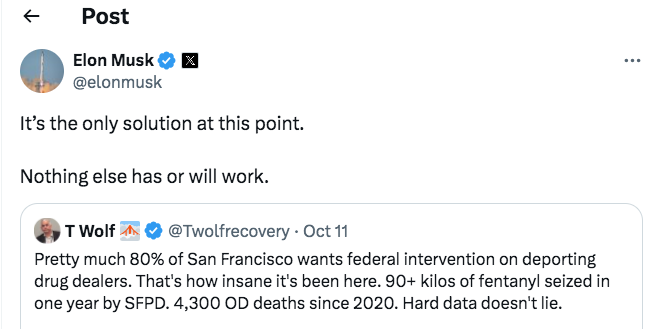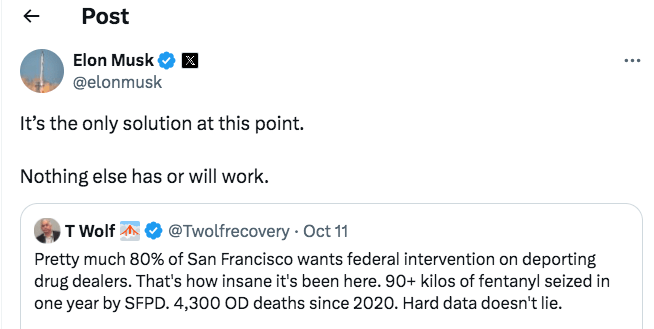Dreamforce brought more than its usual fanfare in October when Salesforce CEO Marc Benioff publicly suggested that National Guard troops might be needed to help “clean up” San Francisco. These discussions were quickly amplified by viral X reposts from recovery advocate Tom Wolfe and entrepreneur Elon Musk regarding a citywide survey conducted in March 2025.
The study found that 83 percent of San Francisco voters agreed with the statement: “Our city needs federal help and resources to deport undocumented fentanyl dealers.” Benioff’s remark was quickly scaled back after city and state officials expressed concern over the optics of military personnel marching down Market Street. But the social media posts quickly turned to action when multiple sources reported that the federal National Guard would be arriving at Coast Guard Island in Alameda.
Partisan tensions escalated as local and state officials weighed in, especially those with reported ambitions for higher office. On Oct. 10, San Francisco District Attorney Brooke Jenkins tagged President Trump and the Secretary of Homeland Security in a post stating:
I am responsible for holding criminals accountable, and that includes government and law enforcement officials when they cross the bounds of the law. Let me be clear. If you come to San Francisco and illegally harass our residents, use excessive force, or violate any legal boundaries, I will not hesitate to do my job and hold you accountable just like I do other violators every single day.
San Francisco Unified School District Superintendent Maria Su and California Senator Scott Wiener sent out emails stirring fear in the immigrant community about U.S. Immigration and Customs Enforcement (ICE) agents and what actions to take. Wiener wrote, “This is a frightening time” and “These are dark days,” while citing resources such as the ACLU of Northern California, which sued the city of San Francisco in 2022 for trying to clean up homeless encampments.
Then on Oct. 23, Speaker Emerita Nancy Pelosi reposted a message stating, “Police may arrest federal agents who violate California law.” In response, U.S. Deputy Attorney General Todd Blanche posted, “Stand down or face prosecution,” invoking the U.S. Constitution’s Supremacy Clause, which affirms the primacy of federal law over conflicting state or local statutes.
Also on Oct. 23, San Francisco Mayor Lurie issued a public statement confirming that he had spoken with the U.S. president and was assured there would be no surge of National Guard troops into the city. His statement said, “… we would welcome continued partnerships with the FBI, DEA, ATF, and U.S. Attorney to get drugs and drug dealers off our streets, but having the military and militarized immigration enforcement in our city will hinder our recovery.”
Later that day, Donald Trump posted on Truth Social: “Great people like Jensen Huang, Marc Benioff, and others have called saying that the future of San Francisco is great. They want to give it a “shot.” Therefore, we will not surge San Francisco on Saturday. Stay tuned!”
What’s the background on federal forces in San Francisco regarding the fentanyl crisis? The city has been leveraging the federal Fast Track program to expedite the prosecution and deportation of fentanyl traffickers through the U.S. District Court system. The initiative was facilitated through coordination between the San Francisco District Attorney’s Office and Speaker Emerita and Congresswoman Nancy Pelosi, enabling sustained collaboration with federal agencies, including the DEA and FBI.
In 2023, Gov. Gavin Newsom deployed nearly 400 National Guard troops to assist local law enforcement in addressing the city’s fentanyl crisis. While their presence was welcomed, the guard’s operational scope remained limited. Under federal law, National Guard personnel face strict constraints when deployed in a federalized capacity, particularly in sanctuary jurisdictions. Their authority to arrest or prosecute is restricted unless activated under state command, and even then, their role is primarily supportive.
The table below outlines the training and authority of five federal forces operating in San Francisco: Drug Enforcement Administration (DEA), Federal Bureau of Investigation (FBI), the Bureau of Alcohol Tobacco and Firearms (ATF), National Guard, and the Department of Homeland Security (DHS). It highlights a critical distinction: while the National Guard contributes surveillance and logistical support, the DEA, FBI, and DHS agents are equipped with the legal authority and specialized training required for narcotics enforcement, prosecution, and cross-border coordination.

The narcotics-centric capabilities are:
– Prosecution-readiness: DEA and FBI agents receive training in evidence handling, informant management, and courtroom preparation to ensure cases meet federal standards.
– Clandestine lab and overdose death investigations: DEA trains in the detection, disruption, and prevention of drug production, trafficking, and distribution of synthetic opioids. This also involves strategic collaboration between law enforcement, forensic scientists, and prosecutors.
– International extradition and reentry prevention: DHS works with the Department of Justice’s Office of International Affairs to track and extradite traffickers who reenter the U.S. illegally after deportation.
These capabilities are supported by strategic staging locations, most notably Coast Guard Island in Alameda, a federally controlled base with maritime narcotics detection and disruption authority. Coast Guard Island serves as a secure operational hub for DHS agencies due to its proximity to the Port of Oakland and its restricted-access infrastructure. The base is equipped to disrupt narco-traffickers before they reach urban centers.
Beyond Coast Guard Island, other critical entry points into San Francisco include:
– Port of San Francisco: A major commercial and cruise terminal vulnerable to container-based trafficking.
– San Francisco International Airport (SFO): A high-volume international gateway.
– Bay Bridge and Golden Gate Bridge: Key land routes for regional trafficking, often monitored through joint task forces and mobile surveillance units.
– Postal and parcel hubs: Fentanyl is frequently shipped in small quantities via mail, requiring detection, disruption, and coordination with postal inspectors and DEA.
Together, San Francisco’s entry points, air, sea, land, and parcel, form a complex enforcement landscape. Federal agents must be trained not only in tactical detection and disruption, but in legal thresholds, forensic documentation, and international coordination to ensure long-term disruption of trafficking networks.
Recent cases underscore the stakes: individuals deported for fentanyl trafficking have returned to San Francisco multiple times and resumed dealing. This begs the question of whether sentencing disparities are further complicating the landscape. Under federal law, dealers whose drugs result in death face mandatory minimums of 20 years. Yet in early 2025, federal prosecutors in the Northern District of California negotiated a plea deal of eight years for Hanti Gamez, whose fentanyl-laced supply killed a beloved San Francisco teacher. By contrast, similar convictions in other jurisdictions have resulted in sentences ranging from 15 to 22 years.
U.S. District Judge William Alsup has criticized fentanyl dealer sentencing as “too lenient” and “ridiculous.” Diaz-Cruz was to receive a sentence of just over a month in jail, plus deportation. Federal defense attorney Jerrod Thompson demanded a recusal, but Judge Alsup was clear: “I am convinced that prison time and strong measures are necessary to deal with the fentanyl crisis,” he said. “It’s killing people. Two people a day in San Francisco.” The battle in the San Francisco federal courts continues.
While federal agencies target the supply side, the demand side remains a public safety and civic challenge. More than 8,000 homeless addicts cycle through emergency rooms, jail bookings, and overdoses without sustainable recovery interventions in San Francisco.
Related


